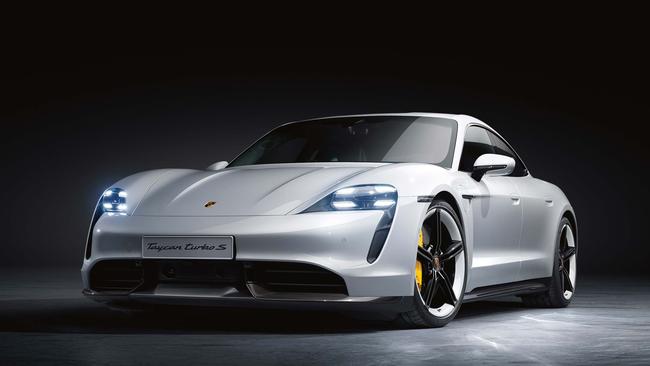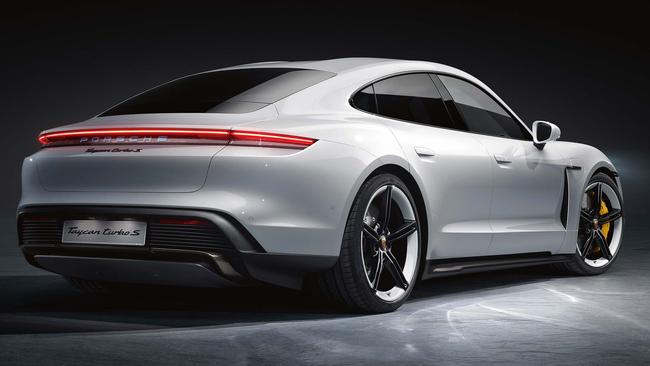Porsche Taycan review: an utterly different beast
Porsche unveils its first pure electric sportscar.

They say you only get one chance to make a first impression, so the debut electric cars coming thick and fast from traditional makers have a lot resting on their shoulders. They must translate familiar brand values into the foreign language of kilowatt-hours and state-of-charge, and persuade buyers to adopt the lingo. So it’s a little surprising to learn that the first proper noun in Porsche’s electric lexicon – Taycan – is supposed to be pronounced “tie-carn”. It’s certain to be a source of confusion.
Porsche counts its eponymous founder as an electric pioneer, though that was 120 years ago and an idea well before its time. Its modern-day electric journey began a decade ago with hybrid versions of its largest vehicles, the Panamera sedan and Cayenne SUV, now offered as plug-ins. The 918 Spyder of 2013 was among the first wave of petrol-electric hypercars and Porsche chalked up three Le Mans wins using a hybrid driveline.
Although comparisons with Tesla are inevitable, Porsche says it focused on its own targets for the Taycan. The firm’s reputation has been forged over decades of making sportscars with bullet-proof high-speed durability, and it wanted its first pure-electric car to be the same, with top-drawer range, charging time and performance. The four-door Taycan should feel as much as possible like a 911, its cornerstone car.
With this in mind, it decided to use the Turbo badge as a marker for top-tier variants. “We’ve had Turbo as a sub-brand since the legendary 911 Turbo in the 1970s,” says R&D chief Stefan Weckbach. So the Taycan arrives as either a Turbo or Turbo S, with prices expected to start around $300k when it reaches Australia late next year, with the S another $50k. A more affordable model should join later, along with wagon versions. The S gets richer trim, more kit, bigger brakes and wheels, and more power.
There’s evidence of intense Porsche development across all aspects of the Taycan, but especially when it involves the driveline. It made a couple of key decisions. First, to use an 800 volt system instead of the usual 400 volts. This means lighter cables and less heat generation, which improves charging times and performance consistency. The second was to fit a two-speed gearbox at the rear electric motor (the front motor has only one gear) to make it quicker off the line. The battery pack has the same capacity in both variants (93.4kWh) and both claim ranges above 400km on European tests. Recharging times vary only slightly and – under ideal conditions – it takes five minutes to pump in 100km, or about 25 minutes to do an 80 per cent refill.

Both have the same 260km/h top speed, but different electronics mean the S has better acceleration. With launch control engaged, it’ll hit 100km/h in just 2.8 seconds; the Turbo takes 3.2 seconds.
As proof of concept, Porsche organised a 6400km run through nine European countries, with an 850km leg from Munich to Berlin for Australian media. We’re driving through the former East Germany on German Unity Day and arrive in Berlin almost exactly 30 years after the wall came down.
If the Taycan sets out to demolish barriers to electric cars, it does a thorough job. In either variant, but especially the S, performance is simply blistering. Using launch control, it delivers throw-you-back-in-the-seat acceleration and Porsche says the car can repeat this trick at least 10 times in a row, giving it an edge over rivals.
In fact, response from the driveline at any speed – up to and beyond typical autobahn speeds – is instant, smooth and irresistible. If the measure of any car is its ability to put a smile on your face, the Taycan passes the test as convincingly as any petrol supercar.
It’s surprising how quickly you get used to its tram-like whirr and the absence of combustion engine sound. An enhancer amplifies some of the more exciting electric noises, although it still sounds much like a hoover picking up a sock.
Dynamically the Taycan is a very different beast to a 911, which is hardly surprising given its utterly different construction. The battery pack is in the floor and car’s centre of gravity is low, but it tips the scales at a substantial 2.3 tonnes and is only slightly shorter than Porsche’s Panamera, at almost 5m long. There’s sophisticated suspension all round, adaptive air dampers and optional rear-axle steering. So it doesn’t feel large on the road, although you can’t fail to be aware of its substantial mass, especially in the wet. The brakes and steering are in line with the brand’s high benchmarks although much of the day-to-day deceleration is performed by the electric motors, which have been tuned to recycle as much energy as possible to the batteries.
In fact, range management is one of the Taycan’s most impressive features. Instead of leaping around in response to different speeds and driving styles, distance-to-empty remains consistent. This engenders confidence, and it’s backed up by clever navigation software that suggests refuelling strategies.
Where it does feel like a 911 is from behind the wheel. Porsche set out to replicate the 911’s driving position, and it’s similarly low and snug here. The differences come down to the freestanding digital instrument screen and new generation control system. Some switchgear – the wing mirror adjustors, for example – can be hard to reach. The rear seats are fine for two, but getting in or out requires sportscar-style limbo-ing. Cargo capacity runs to 447 litres, with most under the tailgate.
From the outside, it presents a fresh face thanks to vertical air intakes which – on white cars especially – give it a Marcel Marceau quality. The new language of electric cars is largely silent, after all.
Porsche Taycan
Motor: 460-560kW/850-1050Nm
Battery: 93.4kWh; range 381-450km
Transmission: Single-speed (front axle) or two-speed (rear axle) automatic, all-wheel drive
Price: From $300,000
Rating: 4.5 out of 5 stars



To join the conversation, please log in. Don't have an account? Register
Join the conversation, you are commenting as Logout